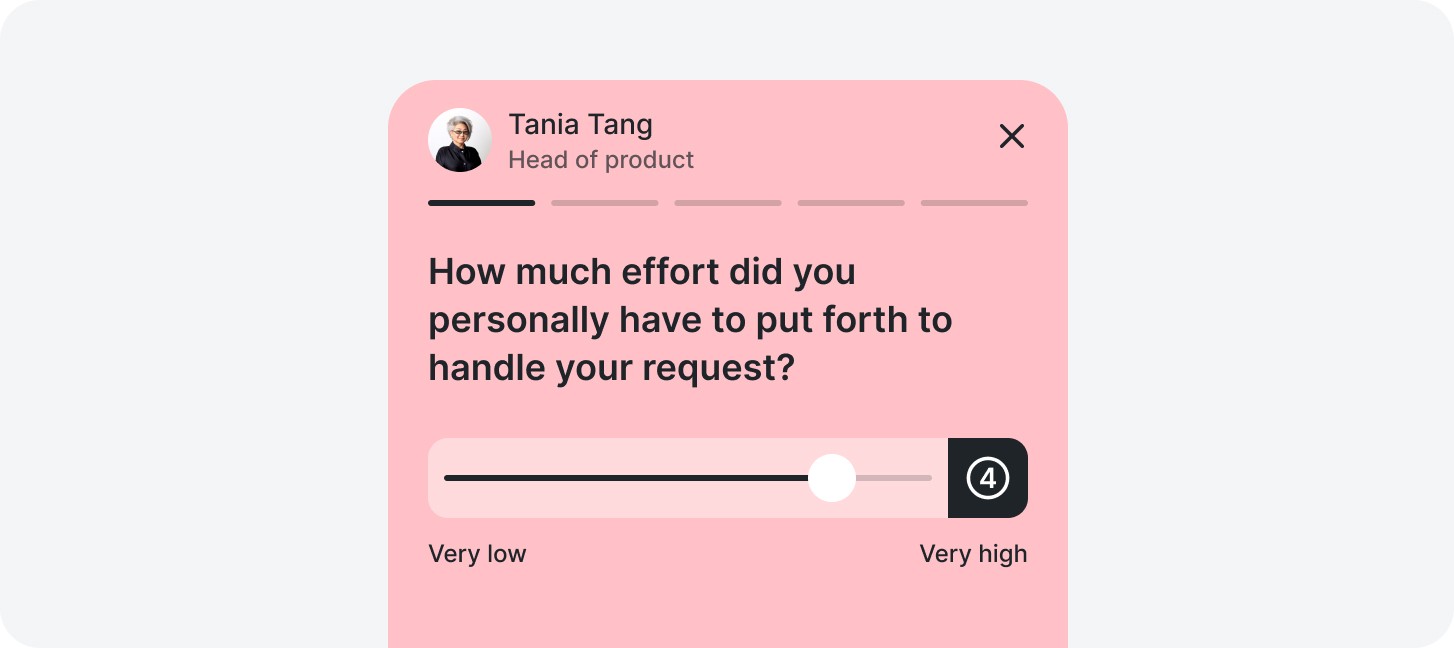Master the Customer Effort Score: A Step-by-Step Guide
Customer Satisfaction

Nicolas Jaussaud
Apr 19, 2023
The CES, helps you to determine if a customer's effort after an experience is acceptable or too high. By measuring customer effort, you can gain valuable insights into your customers' experience, identify pain points, and take steps to improve your overall customer experience. It is often used in complex experiences like a payment funnel or contacting a consultant.
In this article, we'll provide you a step-by-step guide to measuring customer satisfaction using the Customer Effort Score (CES). We'll explain what the CES is, why it's important, and how it can be used to measure customer satisfaction. It also includes detailed instructions on how to calculate the CES score, interpret the results, and use the insights collected to make data-driven decisions that drive growth.
Understanding the Customer Effort Score (CES)
The CES is based on the idea that customers want their experiences to be as effortless as possible. When customers encounter obstacles or difficulties in completing a task, they can become frustrated and dissatisfied with the experience.
The CES is typically measured by asking customers a single question after an interaction or transaction: How easy was using [functionality] so far?. Customer can rate their effort on a scale from "1 = very low" to "5 = very high".

At Told, we like to ask a second question to understand why the respondent gave this rating. We simply ask the question Why?.
The CES is measured over time and quantity which makes it a valuable metric for observing the behavior of your users. To measure the CES the perfect survey format is the in-app survey. Moreover, in-app surveys appear right after the experience, on the spot. It is much better than by email 3 days after the experiments, the answers will be more reliable. Here is an example of a CES questionnaire, you can create your own by clicking here.
Why measure customer effort?
Measuring customer effort is crucial for businesses that want to improve their customer experience and increase customer loyalty. Here are some key reasons why:
Effort is a major driver of customer satisfaction: Research has shown that customer effort is a major factor in determining customer satisfaction. Customers who have to put in a lot of effort to complete a task or transaction are more likely to be dissatisfied and less likely to return to the business.
Effort is a key predictor of loyalty: When customers have a low-effort experience, they are more likely to remain loyal to the brand and recommend it to others. On the other hand, customers who have a high-effort experience are more likely to switch to a competitor.
Effort is a measurable and actionable metric: Measuring customer effort is a relatively simple and straightforward process, and the results can be used to identify pain points and improve the customer experience. By tracking the CES over time, businesses can monitor their progress and adjust their strategies accordingly.
Customers expect a low-effort experience: In today's fast-paced and competitive marketplace, customers expect businesses to provide a seamless and effortless experience. Failing to meet these expectations can lead to lost customers and negative reviews.
We have seen why to measure your CES, in the next section we will see how to measure it with the best practices.
Best practices for successful CES implementation
To properly measure the CES, you need to follow some requirements:
collecting a lot of data
measuring it continuously over time
asking customers to fill out a survey immediately after their experience
For a long time, I have tried to measure the satisfaction of my clients by using the good practices I just mentioned. But I never got the results I was looking for. For example I used Typeform, I sent an email survey to everyone who paid. Unfortunately, the response rates were too low. I also tried sending surveys via SMS, which had a better response rate, but the answers often came in 24 hours after the experience and were not helpful.
That's why we created Told. We are convinced that the future of surveys is in-app. By displaying attractive surveys right after the checkout process, we can achieve a much higher response rate, and the responses are more valuable because they are fresh in the customer's mind. To make it easy for you to create your own in-app satisfaction survey, we've created a template that you can access by clicking here.
Calculating your CES score
CES is calculated by adding all the customer effort scores divided by the total number of responses.
For example, if you received 100 responses and the total score was 350, you would divide 350 by 100 to get an average score of 3.5. This is an average score, you can do better.

It's important to understand why your users gave you that rating. That's why you should always add a second question to your questionnaire, to ask them.
Using Your CES data to improve customer experience and loyalty
Now that you have calculated your CES score, it's time to put that data to work. By understanding where your customers are experiencing high levels of effort, you can take steps to improve their experience and build loyalty.
Here are some ways you can use your CES data to drive business growth:
Identify Pain Points: Look for patterns in your CES data to identify areas where customers are experiencing high levels of effort. For example, if customers consistently report difficulty navigating your website or finding answers to their questions, you may need to improve your self-service options or invest in better search functionality.
Take Action: Once you have identified areas of opportunity, take action to address those pain points. This might involve redesigning your website, improving your customer service training, or streamlining your checkout process. Whatever the solution is, make sure you communicate the changes to your customers and ask for feedback to ensure you're on the right track.
Measure Progress: Keep measuring your CES score on a regular basis to track your progress and ensure your efforts are making a difference. By continuing to collect feedback and monitor your CES score, you can stay on top of changes in customer sentiment and identify new areas for improvement.
By using your CES data to improve your customer experience, you can build stronger relationships with your customers and drive business growth over the long term. So start measuring your CES score today and take the first step toward a better customer experience.
Conclusion: Harnessing the power of CES to grow your business
In today's competitive business landscape, providing an exceptional customer experience is more important than ever. By measuring your Customer Effort Score (CES), you can gain valuable insights into your customers' experience and take steps to improve it.
CES is a powerful metric because it focuses on the effort required by the customer, which is a key driver of loyalty and satisfaction. By reducing customer effort, you can build stronger relationships with your customers and drive business growth over the long term.
To get started with measuring your CES score, follow the steps outlined in this guide:
Understand the CES metric and how it is calculated.
Use in-app surveys to collect feedback on a continuous basis.
Analyze your data to identify areas of opportunity and take action to improve your customer experience.
Measure your progress over time to track the impact of your efforts.
Remember, CES is just one part of the equation when it comes to measuring customer satisfaction. To get a complete picture of your customers' experience, you should also consider other metrics like Net Promoter Score (NPS) and Customer Satisfaction Score (CSAT).
By harnessing the power of CES and other customer satisfaction metrics, you can create a customer-centric culture that drives business growth and builds lasting relationships with your customers. To understand your users, and measure your customer satisfaction, click here.







